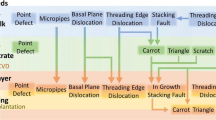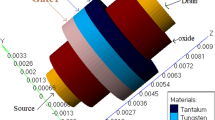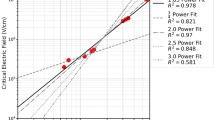Abstract
Finite element modeling (FEM) has been undertaken to characterize the effect of copper (Cu) elasto-plastic behavior on the induction of stress in 3D crystalline silicon (Si) systems incorporating Cu through-silicon vias (TSVs). Using a linear isotropic hardening model, simulations of thermal annealing cycles in Cu TSVs indicate that, for sufficient anneal temperatures, plastic yield within the Cu leads to substantial residual stress in the neighboring Si following cool-down. Simulated Si stress profiles of annealed isolated TSVs agreed with experimental Raman microscopy measurements of post-anneal stress profiles in Si near isolated 5 × 25 μm cylindrical TSVs on a 300 mm Si wafer. Simulations were expanded to investigate the impact of Cu plasticity (yield stress and tangent modulus) on the residual stress profile in Si near isolated TSVs and linear TSV arrays. The results show that the magnitude and extent of the TSV-induced stress field in Si is a non-monotonic function of Cu yield stress. Moreover, the tensile or compressive nature of TSV-induced stress within and outside linear TSV arrays is also a strong function of the Cu yield stress. The simulated impact of Cu tangent modulus on TSV-induced stress in Si is less substantial. The implications of these results for TSV layout with respect to active device placement in a 3D system are discussed.








Similar content being viewed by others
Abbreviations
- TSV:
-
Through-silicon via
- CTE:
-
Coefficient of thermal expansion
- FEM:
-
Finite element modeling
- RIE:
-
Reactive ion etching
- CMP:
-
Chemical mechanical planarization
References
Barnat S, Fremont H, Gracia A, Cadalen E, Bunel C, Neuilly F, Tenailleau J-R (2010) Design for reliability: thermo-mechanical analyses of stress in through silicon via. Proc EuroSimE 2010. doi:10.1109/ESIME.2010.5464559
Beyne E (2006) The rise of the 3 rd dimension for system integration. Proc IITC 2006. doi:10.1109/IITC.2006.1648629
Chen Z, Song X, Liu S (2009) Thermo-mechanical characterization of copper filled and polymer filled TSVs considering nonlinear material behaviors. Proc ECTC 2009. doi:10.1109/ECTC.2009.5074192
De Wolf I (1996) Micro-Raman spectroscopy to study local mechanical stress in silicon integrated circuits. Semi Sci Tech. doi:10.1088/0268-1242/11/2/001
De Wolf I, Maes HE, Jones SK (1996) Stress measurements in silicon devices through Raman spectroscopy: bridging the gap between theory and experiment. J Appl Phys. doi:10.1063/1.361485
International Technology Roadmap for Semiconductors (ITRS). http://public.itrs.net accessed 10 December 2010
Karmarkar AP, Xu X, Ramaswami S, Dukovic J, Sapre K, Bhatnagar A (2010) Material, process and geometry effects on through-silicon via reliability and isolation. Proc Mater Res Soc Symp 2010. doi:10.1557/PROC-1249-F09-08
Kuhn S, Kleiner M, Ramm P, Weber W (1995) Interconnect capacitances, crosstalk and signal delay in vertically integrated circuits. Proc IEDM 1995. doi:10.1109/IEDM.1995.499189
Lu K, Zhang X, Ryu S-K, Huang R, Ho P (2009) Thermal stresses analysis of 3-D interconnect. Proc AIP Conf 2009. doi:10.1063/1.3169263
Okoro C, Yang Y, Vandevelde B, Swinnen B, Vandepitte D, Verlinden B, De Wolf I (2008) Extraction of the appropriate material property for realistic modeling of through-silicon-vias using μ-Raman spectroscopy. Proc IITC 2008. doi:10.1109/IITC.2008.4546912
Ramakrishna G, Liu F, Sitaramana SK (2002) Role of dielectric material and geometry on the thermo-mechanical reliability of microvias. Proc ECTC. doi:10.1109/ECTC.2002.1008133
Ramm P, Wolf MJ, Klumpp A, Wieland R, Wunderle B, Michel B (2008) Through silicon via technology – Processes and reliability for wafer-level 3D system integration. Proc ECTC. doi:10.1109/ECTC.2008.4550074
Ranganathan N, Prasad K, Balasubramanian N, Pey KL (2008) A study of thermo-mechanical stress and its impact on through-silicon vias. J Micromech Microeng. doi:10.1088/0960-1317/18/7/075018
Vandevelde B, Jansen R, Bouwstra S, Pham N, Majeed B, Limaye P, Beyne E, Tilmans HAC (2010) Thermo-mechanical design of a generic 0-level MEMS package using chip capping and through silicon via’s. Proc EuroSimE. doi:10.1109/ESIME.2010.5464539
Acknowledgments
B.B. would like to thank Jihan Capulong for many useful discussions regarding the simulation software and model development. This work was funded by SEMATECH under Contract 402333-NY.
Author information
Authors and Affiliations
Corresponding author
Additional information
Responsible Editor: E.J. Marinissen
Rights and permissions
About this article
Cite this article
Backes, B., McDonough, C., Smith, L. et al. Effects of Copper Plasticity on the Induction of Stress in Silicon from Copper Through-Silicon Vias (TSVs) for 3D Integrated Circuits. J Electron Test 28, 53–62 (2012). https://doi.org/10.1007/s10836-011-5242-7
Received:
Accepted:
Published:
Issue Date:
DOI: https://doi.org/10.1007/s10836-011-5242-7




